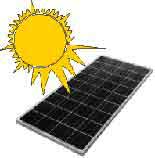Some energy companies are currently investing in a field that has been underutilized until now: solar energy technology.
 |
Converting solar energy into electricity using solar panels |
According to these companies, it won’t be long before we can cool our homes using energy generated from sunlight in scorching desert regions.
Deserts are becoming hotspots for generating electricity from solar heat, where sunlight is concentrated to create steam that drives turbines at power plants. This technique is distinct from the method used in solar panels installed on rooftops.
Small experimental plants built in the 1980s in California, USA, faced difficulties when energy prices fell. However, due to the rising prices of oil, natural gas, and electricity, companies are now racing to construct solar thermal plants that rival traditional power plants.
According to Burghard von Westerholt, the director of solar thermal energy at the private company SCHOTT in Germany, “this technology is being reactivated“.
Technology experts state that current limitations and potential future restrictions on greenhouse gas emissions have also spurred the development of new technologies.
In early February 2006, International Automated Systems Inc. in Utah, USA, signed an agreement to install a 100 megawatt power plant valued at $150 million for Solar Renewable Energy in Nevada, USA.
Similarly, Solargenix in North Carolina recently broke ground on a 64 megawatt solar thermal power plant, valued at $100 million, called Nevada Solar One. The company announced that this will be the first commercially operational solar thermal power plant in the USA, set to commence operations in 2007.
Currently, solar energy accounts for only about 1% of the total electricity produced annually in the USA. A significant barrier for this energy source is cost. Electricity generated from solar thermal energy currently costs between 12-15 cents per kilowatt-hour, while electricity from natural gas costs about 10 cents per kilowatt-hour.
SCHOTT will also supply components for at least one solar thermal power plant with a capacity of 50 megawatts each year in the deserts of the Southwestern USA, according to Mr. Westerholt.
He noted that the intense sunlight in this region and the increasing population have made it an ideal area for such development. SCHOTT plans to establish a manufacturing center in the USA, which will provide approximately 100 jobs.
Solar thermal energy is also being developed worldwide. The best locations for solar thermal plants are Australia, the USA, Spain, the Middle East, and North Africa. These regions can potentially export solar-derived energy to Europe and other countries via high-tech power lines.
Fred Mayes, an expert on alternative energy at the U.S. Energy Information Administration, stated that solar thermal energy is still relatively expensive compared to energy generated from wind and biofuels. However, solar thermal energy has distinct advantages. Electricity generated from solar thermal energy in deserts is more reliable than wind-generated electricity during the day, when prices peak. Unlike fuels produced from biomass waste, solar electricity generation does not emit greenhouse gases.
Rhone Resch, President of the Solar Energy Technology Association based in Washington, D.C., stated that this technology is ideal for providing electricity to the Western U.S., where energy supply is limited and prices are high.

















































